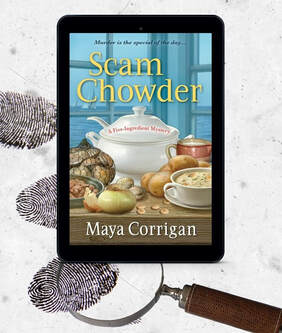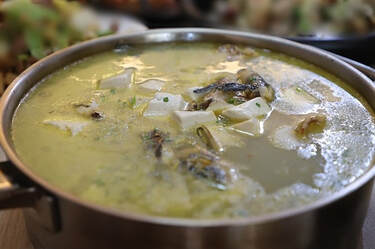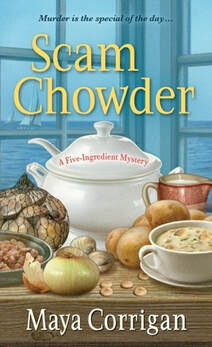Chowder in History and Literature
|
While writing Scam Chowder, the second Five-Ingredient Mystery, I researched the history of chowder. The word usually applies to a hearty fish soup, almost a stew.
Chowder originated as a potluck meal. When men from the fishing villages along the Atlantic coast of France returned home with their catch, the community celebrated by preparing a thick soup or stew with ingredients from each family. Some contributed fish, others vegetables or seasonings. Whatever they had, they threw into the pot. Later, as people from the fishing villages relocated to Canada, they brought their culinary traditions with them. Eventually, the French word for the large pot or cauldron (chaudière) used to make the villagers' soup morphed into the English word chowder. This way of cooking fish migrated down to New England and farther south along the Atlantic coast and eventually across the country, with variations developing in each region. |
|
Chowder even entered into literature, with a chapter in Herman Melville's Moby Dick devoted to it. Melville's character, Ishmael, describes the clam chowder of 19th century New England: “It was made of small juicy clams, scarcely bigger than hazel nuts, mixed with pounded ship biscuit, and salted pork cut up into little flakes; the whole enriched with butter, and plentifully seasoned with pepper and salt.”
Today clam chowder comes in several varieties: white or New England chowder, made with milk or cream; red or Manhattan chowder, made with tomatoes; and the light broth-based chowder found in Rhode Island, around parts of the Chesapeake Bay, and Cape Hatteras. |
|
A recipe for the Chesapeake version of light chowder appears in Scam Chowder. The cover illustrates the five ingredients that go into this type of chowder. In the book the passing of two different types of chowder around the table serves as a clue to the murderer’s identity.
Chowders aren’t just for fish. Hearty soups made with chicken or vegetables are also known as chowders. Read more about Scam Chowder. |
"Chowder in History and Literature" appeared originally on Mystery Lovers' Kitchen, where I blog with other writers of culinary mysteries.


